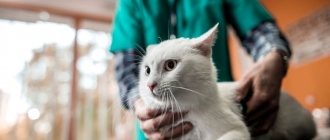4765Pavel
In our cybernetic age, people are still interested in curious questions, for example, what is the difference between a cat and a dog. Both animals are domestic animals, however, there are many differences between them.
Man learned to domesticate dogs over the past 14,000 years. Cats were domesticated 7,000 years later. Initially, dogs evolved from wolves. By coincidence, there have been no such evolutionary changes in the history of cats. Cats were worshiped in ancient Egypt, this is different from the attitude towards dogs. The fact is that cats effectively fought rodents attacking Egyptian granaries.
© shutterstock
See and hear better
- Cats have vision typical of a nocturnal animal. Dogs are for daytime use. This explains why cats have such large (and keen!) eyes. But both of them distinguish colors much worse than humans.
- Cats' hearing is also better developed: it reaches at least 65 kilohertz versus 45 in dogs. Whereas a person has only 20!
- But in the “smell” round, cats give way to primacy. A dog's nose contains 300 million receptors, while cats have "only" 200 million. It’s awkward to talk about a man with his modest 5 million...
Lifestyle
The cat and dog get used to the conditions in which the owner lives very well, and begin to adapt to their character and way of life.
For each animal, conditions must be created so that its life will be long and happy. As soon as a kitten appears in the house, he needs to be shown where the tray is, the place for feeding, the house, and also where he will play. It is necessary to purchase various toys and a scratching post. When the puppy appears, you need to show him the place where he will sleep and toys. Don't forget that a small puppy definitely needs to take care of his teeth so that his favorite shoes don't get damaged. The dog's lifestyle should be active: daily walks 2-3 times a day, joint sports and games in the fresh air. Please your pets and they will please their owner.
Eat more often
All pets love to eat tasty food, but their needs vary greatly. Cat portions are usually smaller than dog portions, but the cat should also have more meals.
In addition, the texture of the food is important for cats. They prefer dense and moist foods, but do not respond well to powdery and sticky textures. A cat that is accustomed to a certain food structure may refuse an unfamiliar type of food - this is important to consider when switching to a new diet.
Cats and dogs should not be fed the same food. Individual food lines take into account not the economic needs of producers, but the physiological differences of animals: intestinal length, tooth size and enzyme activity.
The physical characteristics of pets are obvious at first glance
Claws are a clear indication of the differences between dogs and cats. A dog's claws are blunter than a cat's, simply because they are always on the outside and the dog wears them down on the ground as he walks. The cat has very sharp retractable claws, which it uses for protection and to cling to something, for example, to climb somewhere.
Both dogs and cats can be excellent hunters. However, they catch their prey in completely different ways. Cats love to climb and use their claws to climb trees and then easily jump from heights. Dogs are earthly creatures. Although some of them like to jump, dogs still more often find prey by smell or catch up with it.
Walking on their own
Dog: “We love each other - we are best friends - we like to walk together so much - play with me.”
Cat: “Go away. Come back. I like you. Let me go. Give me something tasty. Leave".
Every joke has some humor in it. Everything else is based on real events and is even scientifically explainable. Dogs are members of a pack and see their owner as parent, friend and leader all rolled into one. Cats, by nature, are solitary animals, but this does not prevent them from expecting tasty food and a fresh tray from their owner.
Fun jogging and swimming with a dog - or the comfort of home and taming an obstinate cat? The choice is yours!
Hunting methods
The cheetah is the fastest land creature.
When hunting, the cheetah focuses on its speed, and, having caught up with the prey, pounces on it, thereby knocking it down. But first, the cheetah must sneak up on the prey unnoticed, and only then jump out of the ambush and run after it. Both the wolf and the cheetah are predators, but the wolf, unlike the cheetah, is a pack animal.
Territorial behavior is also different. Wolves live in a limited territory, but the cheetah does not limit its territory, because it moves from one place to another due to changing environmental conditions. The wolf marks its territory, unlike the cheetah, which results in a highly developed sense of ownership.
Wolf and cheetah are predators. For a wolf, any living object is an object of pursuit, including fish, and for a cheetah, only herbivores and birds are the object of pursuit. The wolf and the cheetah cannot avoid competition in their environment. So the wolf competes with the arctic fox for prey (As Mowat writes, they mainly compete for mice - voles). The cheetah also competes with hyenas and lions for prey. A wolf can also establish friendly contact with an arctic fox, and a cheetah with some kind of bird. Joy Adamson writes: “Pippa soon met a pair of plovers and a secretary bird who teased her shamelessly. The stately, long-legged secretary stood completely still and maliciously watched Pippa, who was rushing towards him; at the last moment he quickly took off, dived at her from the air, and all her attempts to get him were in vain.”
The wolf, unlike the cheetah, is a pack animal. The pack has a strict hierarchy. It is a system with complex relationships, each member of which is tied to each other. The cheetah is a solitary animal and needs a partner only during the mating season.
Wolves primarily hunt in packs, focusing on numbers. The main task when hunting is to catch up and kill prey, or simply surround and tear it to pieces. When hunting, the cheetah focuses on speed, overtaking the prey in a short sprint, and then killing it. Before starting to sprint, the cheetah must quietly sneak up to the prey at a distance of at least 10 - 20 m.
How can I help the grief?
It is often said that with old age, character deteriorates, a person becomes grumpy, intolerant, unbearably suspicious or overly anxious. Psychologists believe that it is not a matter of character damage, but that the loss of mental and physical strength leads to a weakening of control. Previously, a person could control himself, somehow monitor his manifestations, but over the years, self-control weakens and what was previously hidden begins to reveal itself, sometimes in the most inadequate forms.
What should relatives do if their grandmother got a dozen cats? Of course, you can feel sorry for your grandmother and be forgiving of her weakness, or try to appeal to her reason, wasting time on fruitless persuasion, but... unfortunately, the grandmother herself can take any help with hostility, an attempt to clean her apartment or somehow help animals - violence against yourself and cats. And such aggressive behavior once again confirms that the grandmother does not care about cats, but about the safety of her illusory world, where she is the arbiter of the fate of stray cats.
No matter how bitter it may be for your relatives to admit this, it will be almost impossible to explain something to your grandmother with reasonable arguments. Attempts to deceive or persuade will most likely lead to a nervous breakdown of the persuader himself. Moreover, such a situation usually indicates that dialogue with relatives has already been lost.
Depending on the possibility and desire of the relatives, if the situation is close to extreme, uncontrollable, guardianship can be granted over the grandmother - then a relative can make all important decisions for her. You can invite a gerontologist or psychiatrist to visit your grandmother, and do not say what kind of doctor will come, just say - a “doctor” will come.
The specialist will better assess the grandmother’s condition and can prescribe her the necessary medications. You can hire a nurse for such a grandmother, invite a cleaning lady.
There is no need to ask grandma herself for permission to clean the apartment or give away seventeen extra cats, etc. We must try, as calmly and firmly as possible, to bring the situation closer to normal and in the future to maintain order in the elderly person’s home ourselves. It’s not a sin to think about the suffering animals that ended up with such a mistress - untreated, poorly fed, lousy. They would be much better off in the trash heap. If it’s a shame to throw them out there, then you can turn to people who take care of animals and place the cats in shelters.
Because, although we do not have a law stating that you cannot keep twenty cats in an apartment, there is an article of the Criminal Code on cruelty to animals, and in the case of abnormal living in an apartment of dozens of cats, this article is most likely violated. This can be used by neighbors who suffer from the inevitable smell or fleas in such cases.
Elena Zagorodnaya, clinical psychologist
Photo: facebook.com
How are cats physiologically different from dogs?
Basic knowledge of your pet's physiology will help you care for your pets properly.
Many houses often have a cat and a dog. Owners should remember that these two pets are fundamentally different from each other and require an individual approach. Keep the following differences in mind when caring for your pets.
Vision
The eyes of a cat are the eyes of a nocturnal animal, and the eyes of a dog are of a daytime animal. Initially, the cat is the lurking predator, and the dog is the pursuing one. This is why cats have such well-developed vision and their eyes are so large. Both animals distinguish colors equally worse than humans.
Smell
While cats have powerful vision, dogs' strong point is their sense of smell. Cats have fewer taste and smell receptors in their noses than dogs.
If a dog is in a hurry to sniff up and down an unknown object, then the cat is more careful: it walks in circles, touches with its paw, scratches, feels, and only then dares to sniff
Smell
The well-known cleanliness of a cat is not just a whim, but a necessity that has developed over thousands of years. As a lurking predator, the cat must ensure that its prey does not smell it. So the smell is a real cat’s enemy, which is why she washes herself so often, trying to completely eliminate it. The dog has a different hunting tactic. Unlike fast-moving cats, dogs are less agile and agile, but they are more resilient and can pursue their prey until they completely exhaust it. So dogs are not at all bothered by their own “dog” smell.
Toilet
Cats, in order not to give themselves away, prefer to bury their excrement, while dogs, on the contrary, demonstratively and without hesitation mark their territory.
Physical endurance
Cats are less resilient (as in hunting, their actions are precise and swift); they are capable of running very fast, but only over short distances. Dogs, on the contrary, do not run so fast, but they can pursue their prey for a long time and persistently.
Origin
It is believed that dogs were formed as animals in cold climates, so temperatures from 0 to 15 degrees are acceptable for them, they prefer to sleep on a cool floor, and some breeds can even live in the Far North. Cats have “desert” ancestors, and therefore tolerate heat better and prefer warm, cozy places.
Needs
Dogs are practically omnivores, and in cats, normal life activity is possible only by consuming animal protein. Fasting is contraindicated for cats - this can lead to serious health complications. They can eat small portions, but often. Dogs may not eat for several days, but then eat a lot at once. Under no circumstances should animals be fed the same food. Firstly, a dog has a longer intestine than a cat, which means it can eat more roughage plant foods, unlike a cat. Secondly, a cat’s teeth are less developed, so dog food may not be suitable for grinding. And finally, cats have lower activity of enzymes that break down carbohydrates, so a dog can eat plant foods for a long time, but a cat cannot. It is better to choose food individually for your pet.
Source
Taming a dog
When a person tamed a dog, it turned out that it was more sociable, was ready to pay more attention to people, and willingly obeyed their commands.
The US is trying to find a vaccine, but suffers from attempts to hack research data
The bride, having kissed her father, gave him a credit card: the guests laughed, and the groom tensed
If you want to try the gastronomic miracle of Portugal, make pasta dessert
Evolutionary biologist Bridget von Holdt of Princeton University and animal psychologist Monique Udell of the University of Oregon have long observed the behavior of 18 different breeds of dogs and ten people at a center located in Indiana.
They recently conducted a simple experiment. A person familiar and unknown to him was planted not far from the animal. The researchers monitored how the dogs behaved. As expected, they behaved almost identically with both people.
When they were taught to open the box in which the sausage lay, they began to monitor how they would complete the task alone, and how in the presence of a person. Only 2 dogs out of 10 managed to do it in the required two minutes. The rest were ready to open the box, but were waiting to see how the person would react to their actions.











